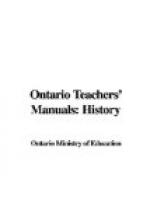T.—Suppose
Britain had trouble with any other country that might
be a cause of war, would
her position make any difference to her?
P.—No country could attack her except by water.
T.—How would she defend herself?
P.—She
would have to depend on her ships. (A good opening
for a
brief outline of the
growth of the navy.)
T.—Where would she get her ships?
P.—She builds them herself.
T.—Isn’t she dependent on any other nation at all?
P.—No,
she has always had the material in her own country
for
that.
T.—What are they built of?
P.—The
old ships were wooden, and she had plenty of the best
timber,—oak.
T.—What are they built of to-day?
P.—Most of them are of iron.
T.—Where does she get that?
P.—From her own mines.
T.—Now,
look at the latitude of Britain. What part of
our
country has the same
latitude?
P.—Labrador.
T.—What is the climate of Labrador?
P.—Very cold.
T.—Then the climate of Britain ought to be the same?
P.—The water around it would make it not so cold.
T.—Yes.
The ocean currents from the south help to make the
climate milder, too.
There would be plenty of rain, besides. Now,
how would a moist, mild
climate affect agriculture in England?
P.—They ought to be able to grow almost everything that we can.
(Similarly, many other points may be taken up and developed with the class.)
ST. LAWRENCE RIVER
INCIDENTAL TEACHING OF HISTORY WITH GEOGRAPHY
Aim.—To show general connection between history and geography.
Material Required.—A black-board sketch of that part of Canada adjacent to the St. Lawrence and a set of pictures (or picture post-cards) showing the important historical sites along the banks of the river.
Introduction.—The teacher asks a few questions to make clear the purpose of the map and to fix the location of the principal towns and cities—Kingston, Brockville, Prescott, Ogdensburg, Morrisburg, Cornwall, Lachine, Montreal, Three Rivers, Levis, Quebec, Tadoussac, and Gaspe.
Presentation.—The lesson is assumed to be a pleasure trip by boat from Port Hope to the Atlantic. The teacher will tell of the departure from Port Hope and the arrival at Kingston, the first port. While there, he will ask why the place was given the name of Kingston. (It was named in honour of George III; as Queenston, at the upper end of the lake, was in honour of Queen Charlotte.) Leaving Kingston the teacher will describe (showing pictures) the appearance of the fort on the point and, with the pupils, will recall its establishment by Frontenac in 1673, and its use as a check on the Indians, and will note its use now as a storehouse, barracks, and training camp for soldiers. (Ontario Public School History, pp. 51, 114.)




